1995 Oldsmobile Cutlass Supreme ESP
[x] Cancel search: ESPPage 170 of 340
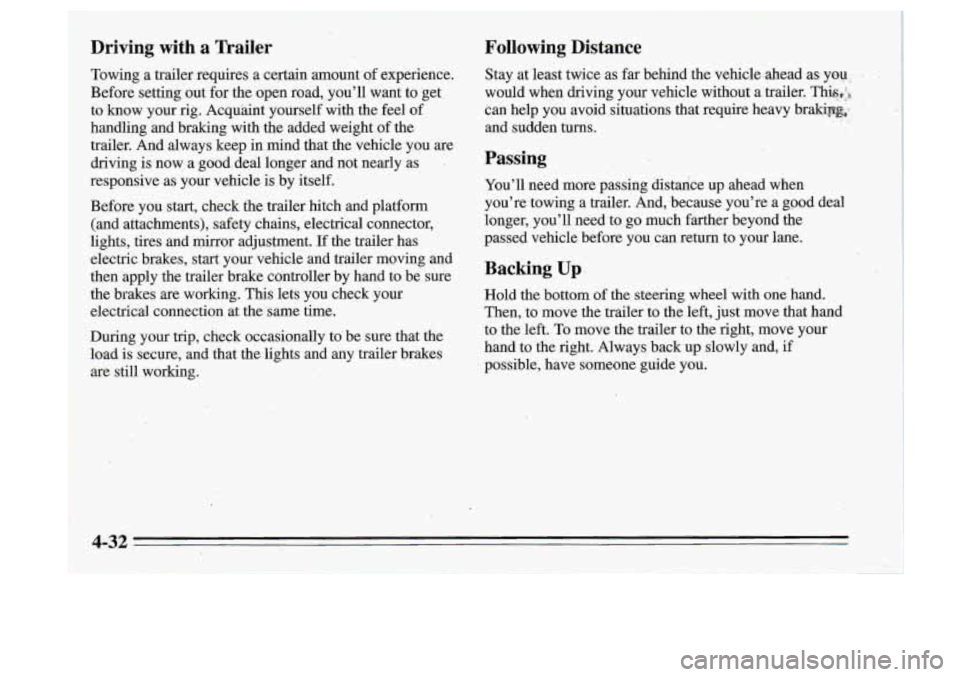
-
I
,'
Driving with a Trailer Following Distance
Towing a trailer requires a certain amount
of experience. Stay at least twice as far behind the vehicle .ahead as- you - .
Before setting out for the open road, you'll want to get would when driving your veh\
icle without a trailer. This$,
to know your rig. AcquQint yourself with the feel of can help you avoid situations that require heavy br-it
and sudden turns.
handling and braking with the added weight of the
trailer. And always keep in mind that ,the vehicle you are
driving is now a good deal longer
and not nearly as . Passing
responsive as your vehicle is by itself. You'll need more passing distance up ahead when
Before you start, check the.trailer hitch and platform you're' towing a trailer. And, because you're a good deal
(and attachments), safety chains, electrical connector, longer, \
you'll need to go much farther beyond the
lights, tires and mirror adjustment.
If the trailer has passed vehicle before you can return to your \
lane.
electric brakes, start your vehicle and trailer moving and
the brakes are working. This lets you check ,your Hold the bottom
of the steering wheel with one hand.
electrical connection at the same time. Then, to move the trailer
to the left, just move that hand
During your
trip, check occasionally to' be sure that the to the left.
To move the trailer to the right, move your
load is secure, and that the lights and any trailer brakes hand to the right. Always back up slowly and, if
are still working. possible. have someone guide you.
.. . ~.
then apply the trailer brake controller by hand to be sure Backing Up
?'
Page 172 of 340
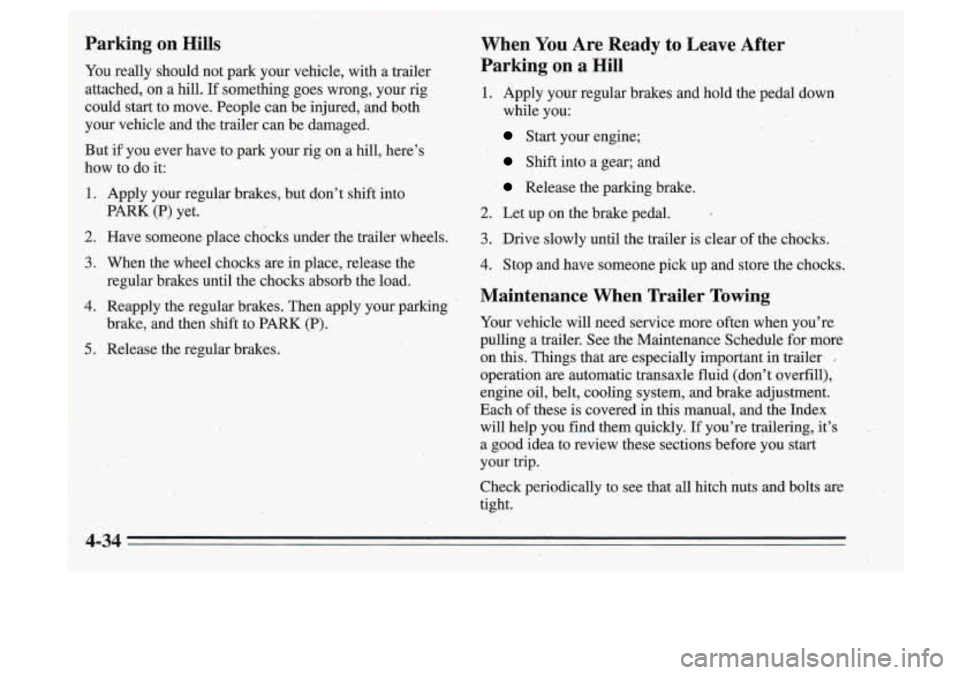
Parking on Hills
You really should not park your vehicle, with a trailer
attached,
on a hill. If something goes wrong, your rig
could start to move. People can be injured, and
both^
your vehicle and the trailer can be darnaged.
But if you ever have to park your rig on a hill, here’s
how to do it:
.I. Apply your regular brakes, but don’t shift into
.. !PARK (P) yet.
2. ‘Have someone place chocks under the trailer wheels.
3. When the wheel chocks are in place, release the
regular brakes until the chocks absorb the load.
4. Reapply the regular brakes. Then apply your parking
brake, and then shift to PARK
(P).
When You Are Ready to Leave After
Parking o,n a
Hill
1. Apply your regular brakes and hold the pedal down
8’. .
while you:
Start your engine;
Shift into a gear; and
Release the parking brake.
2. Let up on the brake pedal.
3. Drive slowly until the trailer is dear of the chocks.
4. Stop and have someone pick up and store the chocks.
Maintenance When Trailer Towing
Your vehicle will need service more often when you’re
pulling a trailer. See the Maintenance Schedule for,more
.on this. Things that are especially important in trailer
operation are automatic transaxle fluid (don’t oyerfill),
engine oil, belt, cooling system, .and brake adjustment.
Each of these
is covered in this manual, and the Index
will help you find them quickly. If you’re trailering, it’s
a good idea
to review these sections before you start
your trip.
Check periodically to see that all hitch nuts and bolts are
tight.
4-34,
Page 194 of 340
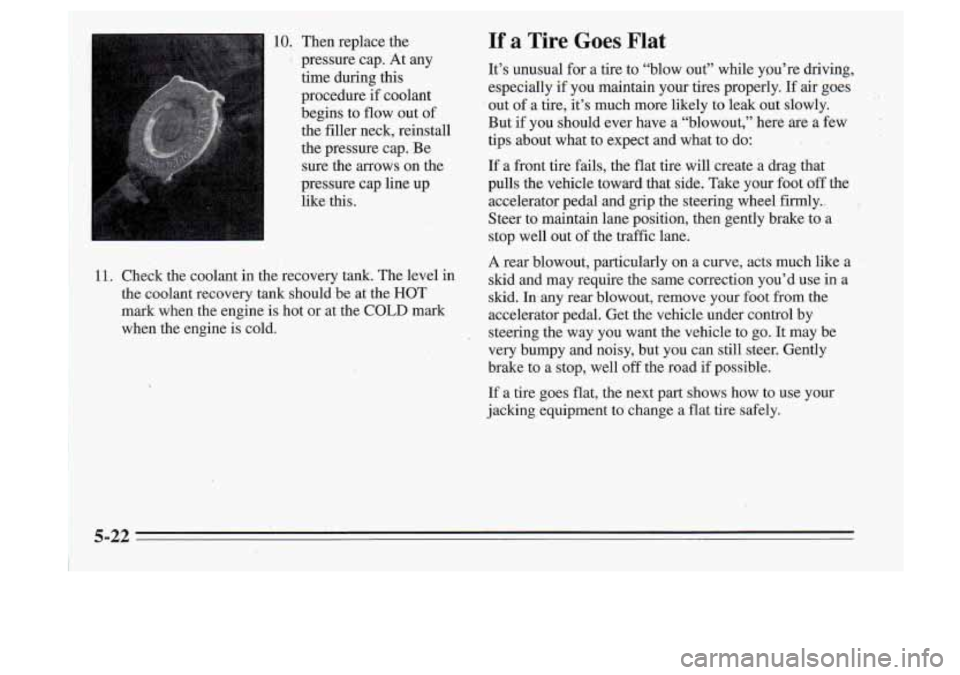
10. Then replace the
’ pressure cap. At any
time during this
procedure if coolant
begins to flow out of
the filler neck, reinstall
the pressure cap. Be
sure the arrows on the
pressure cap line up
like this.
11. Check the coolant in the recovery tank. The level in
the coolant recovery tank should be at the HOT
mark when the engine
is hot or at the COLD mark
when the engine
is cold.
If a Tire Goes Flat
It’s unusual for a tire to “blow out” while you’re \
driving,
especially
if you maintain your tires properly. If air goes
out
of a tire, it’s much more likely to leak out slowly.
But if you should ever have a “blowout,” here are a few
tips about what to expect and what to do:
If a front tire fails, the flat tire will create a drag that
pulls the vehicle toward that side. Take your foot
off the
accelerator pedal and grip the steering wheel firmly.,
Steer to maintain lane position, then gently brake to a
stop well out of the traffic lane.
A rear blowout, particularly on a curve, acts much like a
skid and may require the same correction you’d use in a
skid. In any rear blowout, remove your foot from the
accelerator pedal. Get the vehicle under control by
steering the way you want the vehicle to go.
It may be
very bumpy and noisy, but you can still steer. Gently
brake to a stop, well
off the road if possible.
If a tire goes flat, the next part shows how to
use your
jacking equipment to change a flat tire safely.
Page 208 of 340
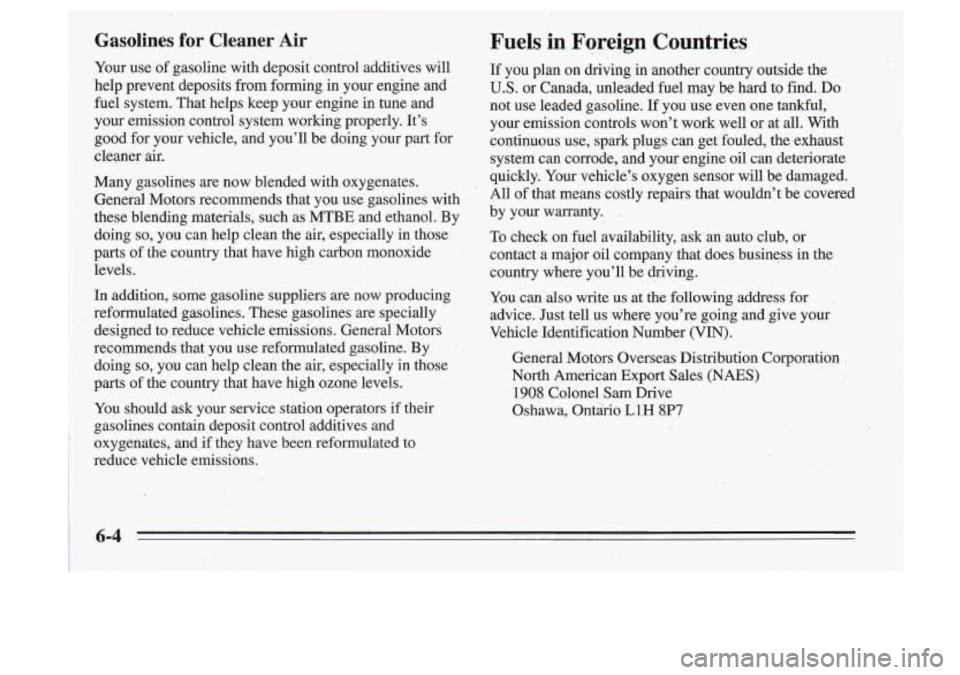
I
Gasolines for Cleaner Air
Your use of gasoline with deposit control additives will
help prevent deposits from forming in your engine and
fuel system. That helps keep your engine in tune and
your emission control system working properly. It’s
good for your vehicle, and you’ll be doing your part for
cleaner air.
Many gasolines are now blended with oxygenates. General Motors recommends that you use gasolines with
these blending materials, such as MTBE and ethanol. By
doing
so, you can help clean the air, especially in those
parts of the country that have high carbon monoxide levels.
In addition, some gasoline suppliers are now producing
reformulated gasolines. These gasolines are specially
designed to reduce vehicle emissions. General Motors
recommends that you use reformulated gasoline. By doing
so, you can help clean the air, especially in those
parts of the country that have high ozone levels.
You should ask your service station operators if their
gasolines contain deposit control additives and
oxygenates, and
if they have been reformulated to
reduce vehicle emissions.
Fuels in Foreign Countries
If you plan on driving in another country outside the
U.S. or Canada, unleaded fuel may be hard to find. Do
not use leaded gasoline. If you use even one tankful,
your emission controls won’t work well or at all. With
continuous use, spark plugs can get fouled, the exhaust
system can corrode, and your engine oil can deteriorate
quickly. Your vehicle’s oxygen sensor will be damaged.
All of that means costly repairs that wouldn’t be covered
by your warranty.
To check on fuel availability, ask an auto club, or
contact a major oil company that does business in the
country where you’ll be driving.
You can also write us at the following address for
advice. Just tell
us where you’re going and give your
Vehicle Identification Number (VIN).
General Motors Overseas Distribution Corporation
North American Export Sales (NAES)
1908 Colonel Sam Drive
Oshawa, Ontario
L1H 8P7
6-4 .I
Page 221 of 340
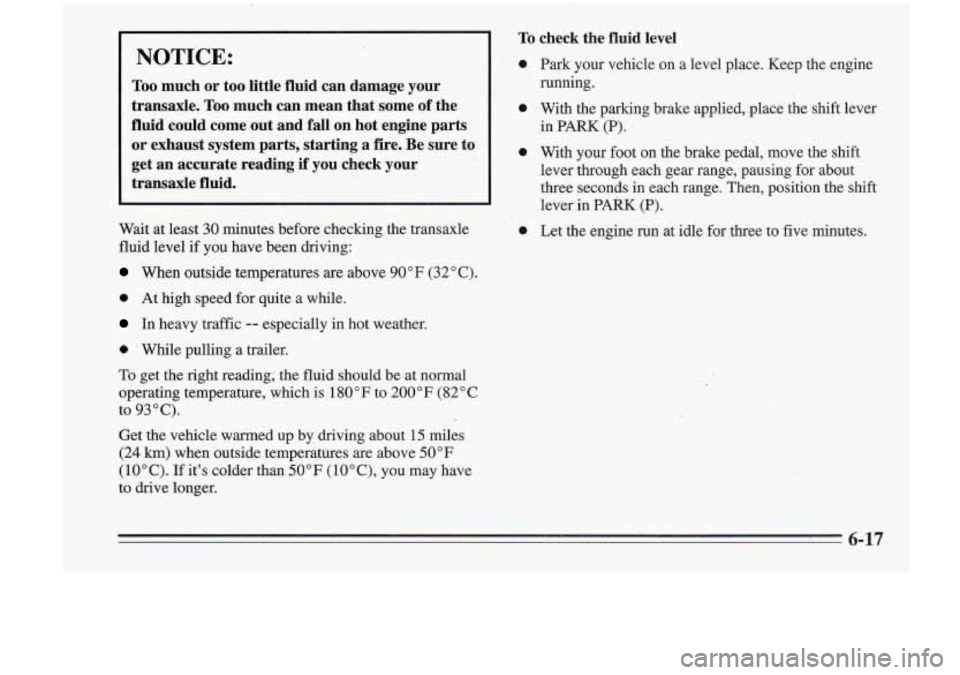
NOTICE:
Too much or too little fluid can damage your
transaxle.
Too much can mean that some of the
fluid could come
out and fall on hot engine parts
or exhaust system parts, starting a fire. Be sure to
get an accurate reading if
you check your
transaxle fluid.
Wait at least 30 minutes before, checking the transaxle
fluid level
if you have been driving:
When outside temperatures are above 90°F (32°C).
0 At high speed for quite a while.
In heavy traffic -- especially in hot weather.
a ' While pulling a trailer.
To get the right reading; the fluid should be at normal
operating temperature, which is 180°F to 200°F (82°C
to 93°C).
Get the vehicle warmed up by driving about 15 miles
(24
km) when outside temperatures are above 50°F
(10°C). If it's colder than 50°F (lO"C), you may have
to drive longer.
To check the fluid level
0
0
0
0
Park your vehicle on a level place. Keep the engine
running.
With the parking brake applied,.place the shift lever
in PARK
(P). J
With your foot on the brake pedal, move the shift
lever through each gear range, pausing for about
three seconds in each range. Then, position the shik:
lever in
PAkK (P).
Let the engine-run at idle for three to five minutes.
6-17
Page 249 of 340
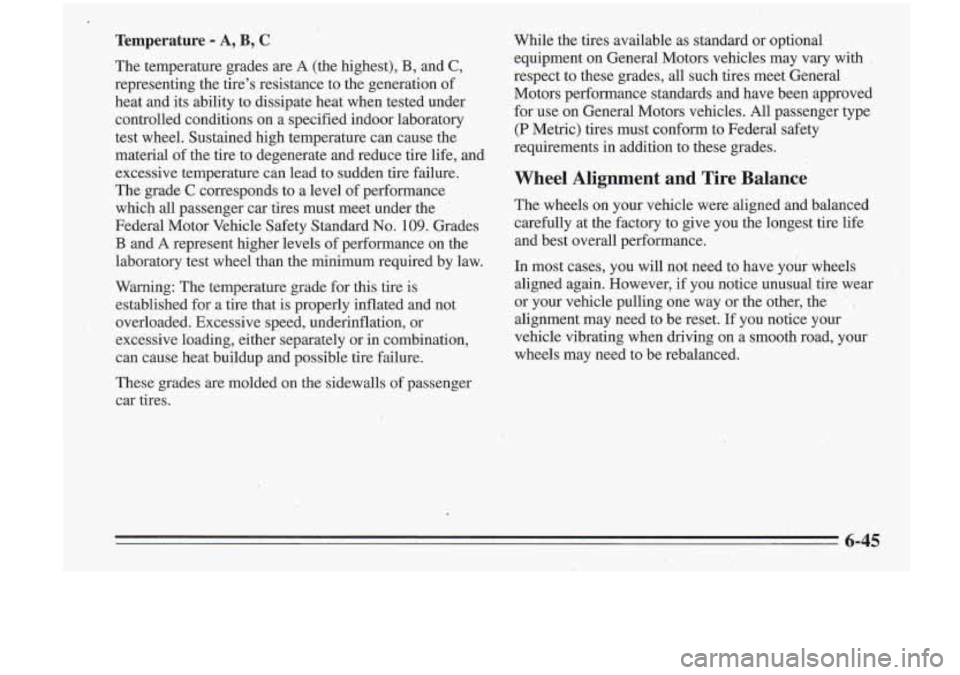
Temperature A, B, C
The temperature grades are A (the highest), B, and C,
representing the tire's resistance to the generation of
heat and its ability to dissipate heat when tested.under
controlled conditions on a specified indoor laboratory
test wheel. Sustained high temperature can.cause the
material
of the tire to degenerate and reduce tire life, and
excessive temperature can lead to sudden tire failure.
The grade
C corresponds to a level of performance
which all passenger car tires must meet under the
Federal Motor Vehicle Safety Standard
No. 109. Grades
B and A represent higher. levels of performance on the
laboratory test wheel than the minimum required by law.
Warning: The temperature grade for this tire is
established for a tire that is properly inflated and not
overloaded. Excessive speed, underinflation, or
excessive loading, either separately or in combination,
can cause heat buildup and possible tire failure.
These grades are molded on the sidewalls of passenger
car tires.
Whili: the tires available as standard or optional
equipment on General Motors vehicles may vary with
,
respect to these grades, all such tires meet General
Motors performance standards and have been approved
for use
on General Motors vehicles. All passenger type
(P Metric) tires must conform to Federal safety
requirements in addition to these grades.
Wheel Alignment and Tire Balance
The wheels on your vehicle were aligned .and balanced
carefully at the factory to give you the longest tire life
and best overall performance.
In mo,st cases, you will not need to have your wheels
aligned again. However, if you notice unusual tire wear
or your vehicle 'pulling one way or the other, the
' ,
alignment may need to be reset. If you notice your
vehicle vibrating when driving on a smooth road, your
wheels may need to be rebalanced.
I
6-45
I . .. I
Page 317 of 340

1 Section 8. .~ -.. Customer Assistance Information
Here you will find out how to contact Oldsmobile if you
need assistance. This section includes information on:
Customer Satisfaction Procedure, Customer Assistance
for Hearing or Speech Impaired,
BBB Auto Line --
Alternative Dispute Resolution Program, Reporting
Safety Defects, Roadside Assistance and Service and
Owner Publications.
Customer Satisfaction Procedure
Your satisfaction and goodwill are important to your
retailer and Oldsmobile. Normally, any concern
with the
sales transaction or the operation of your vehicle will be
resolved by your retailer’s Sales or Service
Departments. Sometimes, however, despite the best
intentions of all concerned, mis,understandings can
occur. If your concern has not been resolved
t.0 your
satisfaction,
the following steps should be taken:
STEP ONE
-- Discuss your concern with a member of
your retail facility management. Normally, concerns can
be quickly resolved at that level.
If the matter has
already been reviewed with the Sales, Service, or Parts Manager, contact the owner
of the retail facility
or the
General Manager.
STEP TWO
-- If after contacting a member of the retail
facility management, it appears your concern cannot be
resolved by the retail facility without further help,
contact the Oldsmobile Customer Assistance Network
by calling 1-800-442-6537., In Canada, contact GM of
Canada Customer Assistance Center in Oshawa by
calling 1-800-263-3777 (English) or 1-800-263-7854
(French).
In Mexico, call (525) 254-3777. In Puerto Rico, call
1-800-496-9992 (English) or 1-800-496-9993
(Spanish).
In the U.S. Virgin Islands, call
1-800-496-9994. In other overseas locations, contact.
GM North American Export Sales in Canada by calling
1-905-644-4112.
8-1 I
Page 329 of 340
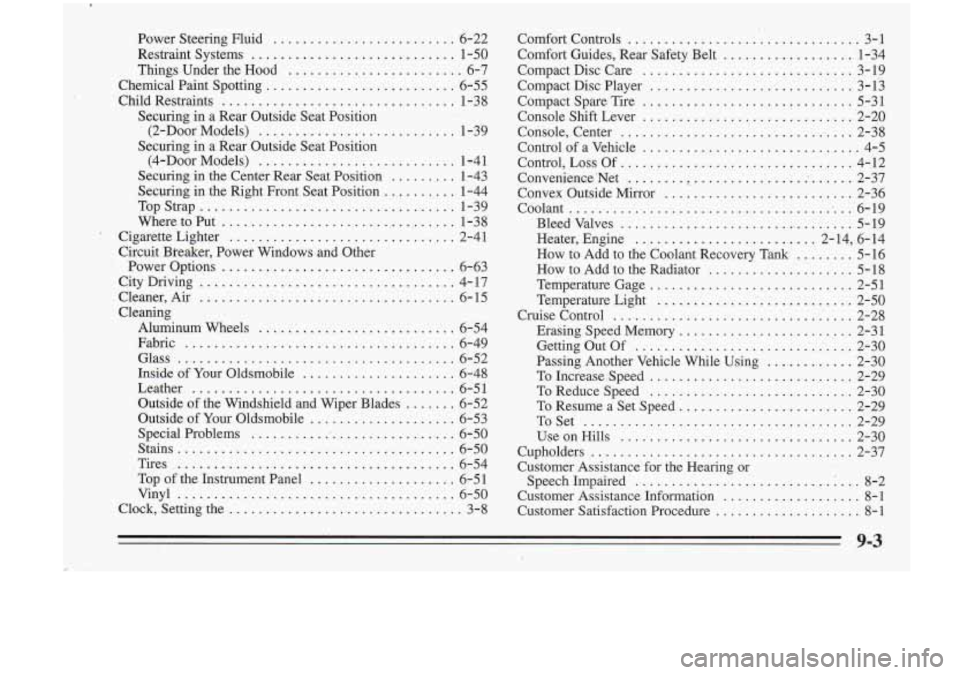
Power Steering Fluid ......................... 6-22
Restraint Systems
............................ 1-50
Things Under the Hood
......................... 6-7
Chemical Paint Spotting
.......................... 6-55
Child Restraints
................................ 1-38
(2-Door Models) ........................... 1-39
(4-Door Models) ........................... 1-41
Securing in a Rear Outside Seat Position
Securing in a Rear Outside Seat Position
Securing in the Center Rear Seat Positioh
.......... 1-43
Securing in the Right Front Seat Position
........... 1-44
TopStrap
................................... 1-39
Where to Put
................................. 1-38
Cigarette Lighter ............................... 2-41
Circuit Bfeaker, Power Windows and
. Other
Power Options
................................ 6-63
City Driving
................................... 4-17
Cleaner,
Air ................................... 6-15
Cleaning Aluminum Wheels
........................... 6-54
Fabric
..................................... 6-49
Glass
...................................... 6-52
Inside
of Your Oldsmobile ..................... 6-48
Leather
.................................... 6-51
Outside of Your Oldsrnobile
.................... 6-53
Special Problems
.............................. 6-50
Stains
...................................... 6-50
.Tires
...................................... 6-54
Top of the Instrument Panel
..................... 6-51
Vinyl
...................................... 6-50
Clock, Setting-the
................................. 3-8
Outside
of the Windshield and Wiper Blades
....... 6-52 Comfort Controls
................................ 3-1
Comfort Guides. Rear Safety Belt
.................. '1-34
Compact Disc Care
............................. 3-19
Compact Disc Player
............................ 3-13
Compact Spare Tire
.............................. 5-31
Console Shift Lever
............................. 2-20
Console. Center
................................ 2-38
Control of a Vehicle
.............................. 4-5
Control. Loss Of
................................ 4-12
ConVenience.Net
........ ....................... 2-37
Convex Outside Mirror
........................... 2-36
Coolant
........................................ 6-19
Bleed Valves
................................. 5-19
Heater, Engine
......................... 2-14, 6-14
How to Add to the Radiator
.................... 5-18
Temperature Gage
........... ; ... ............ 2-51
Temperature Light
........................... 2-50
Cruise Control
................................. 2-28
Erasing Speed Memory
........................ 2-31
Getting Out Of
.............................. 2-30
ToIncreaseSpeed
............................ 2-29
ToReduceSpeed
............................ 2-30
To Resume a Set Speed ......................... 2-29
ToSet
..................................... 2-29
UseonHills
................................ 2-30
Cupholders
.................................... 2-37
Customer Assistance for the Hearing or SpeechImpaired
............................... 8-2
Customer Assistance Information ................... 8-1
Customer Satisfaction Procedure .................... 8-1
How to Add to the Coolant Recovery Tank ........ 5-16
Passing Another Vehicle While Using
............ 2-30